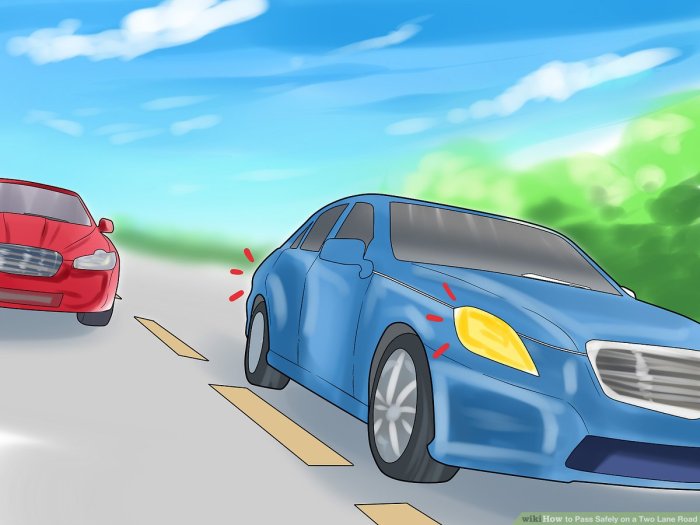After overtaking another motor vehicle, a series of crucial maneuvers and practices come into play to ensure continued safety and adherence to legal regulations. This article delves into the essential post-overtaking considerations, encompassing proper vehicle positioning, safe driving practices, and ethical overtaking etiquette.
Understanding the legal framework and potential risks associated with overtaking maneuvers is paramount. Appropriate and inappropriate overtaking techniques will be examined, highlighting the consequences of improper execution.
Vehicle Maneuvers After Overtaking
After overtaking another motor vehicle, it is essential to perform appropriate maneuvers to ensure safety and maintain traffic flow. These maneuvers include:
Legal Regulations Regarding Overtaking
- Overtaking must only be performed when it is safe and legal to do so.
- Drivers must signal their intention to overtake before commencing the maneuver.
- Drivers must not overtake if there is oncoming traffic or if the vehicle ahead is indicating to turn left.
Appropriate Overtaking Maneuvers
- Overtake on the left-hand side of the vehicle ahead.
- Accelerate smoothly and decisively to pass the other vehicle.
- Return to the original lane promptly after overtaking.
Inappropriate Overtaking Maneuvers
- Overtaking on the right-hand side of the vehicle ahead.
- Overtaking when there is oncoming traffic.
- Overtaking when the vehicle ahead is indicating to turn left.
Potential Risks and Consequences of Overtaking Improperly, After overtaking another motor vehicle
- Collision with oncoming traffic.
- Collision with the vehicle ahead.
- Loss of control of the vehicle.
- Penalties for traffic violations.
Post-Overtaking Vehicle Positioning

After overtaking another vehicle, it is important to maintain a safe following distance and proper lane positioning to minimize the risk of accidents.
Recommended Distance to Maintain Behind the Overtaken Vehicle
The recommended following distance after overtaking is two seconds. This distance allows sufficient time to react to any sudden changes in speed or direction of the vehicle ahead.
Importance of Proper Lane Positioning After Overtaking
Proper lane positioning after overtaking ensures that the overtaking vehicle does not impede the flow of traffic in the adjacent lane. It also reduces the risk of collision with other vehicles.
Factors that Influence Optimal Post-Overtaking Vehicle Placement
- Speed of traffic.
- Visibility of the road ahead.
- Presence of other vehicles.
Safe Driving Practices After Overtaking
Maintaining a safe following distance and proper lane positioning are crucial for safe driving after overtaking. Additionally, drivers should:
Importance of Maintaining a Safe Following Distance
Maintaining a safe following distance allows drivers to react to unexpected events and avoid collisions. The recommended following distance is two seconds.
Role of Situational Awareness and Anticipation in Post-Overtaking Driving
Drivers should be aware of their surroundings and anticipate potential hazards. This includes observing the behavior of other vehicles and road conditions.
Tips for Staying Alert and Responding to Potential Hazards
- Stay focused on the road ahead.
- Avoid distractions such as cell phones and loud music.
- Be prepared to brake or take evasive action if necessary.
Overtaking in Specific Scenarios

Overtaking maneuvers may vary depending on road types and traffic conditions. Drivers should be aware of the challenges and considerations when overtaking in:
Highways
- Higher speeds require greater following distances.
- Limited visibility due to heavy traffic.
- Need for extra caution when overtaking large vehicles.
Narrow Roads
- Limited space for overtaking.
- Increased risk of oncoming traffic.
- Need for careful planning and execution.
Inclement Weather
- Reduced visibility and traction.
- Increased following distances due to slippery road conditions.
- Need for extra caution and defensive driving.
Ethical and Courteous Overtaking

Responsible and considerate overtaking practices are essential for maintaining a harmonious and safe driving environment.
Importance of Responsible and Considerate Overtaking Practices
Aggressive or reckless overtaking can endanger other drivers and disrupt traffic flow.
Potential Impact of Aggressive or Reckless Overtaking on Other Drivers
- Increased risk of accidents.
- Stress and frustration among other drivers.
- Negative impact on traffic flow.
Benefits of Communicating Intentions Clearly Through Signaling and Other Means
Communicating intentions clearly through signaling and other means helps to prevent misunderstandings and accidents.
Key Questions Answered: After Overtaking Another Motor Vehicle
What is the recommended distance to maintain behind an overtaken vehicle?
The recommended distance varies depending on speed and road conditions, but generally, a minimum of two seconds is advisable.
What are the potential consequences of overtaking improperly?
Improper overtaking can lead to collisions, loss of control, and legal penalties.
How can I communicate my overtaking intentions clearly?
Use turn signals, maintain a safe distance, and make eye contact with other drivers when possible.